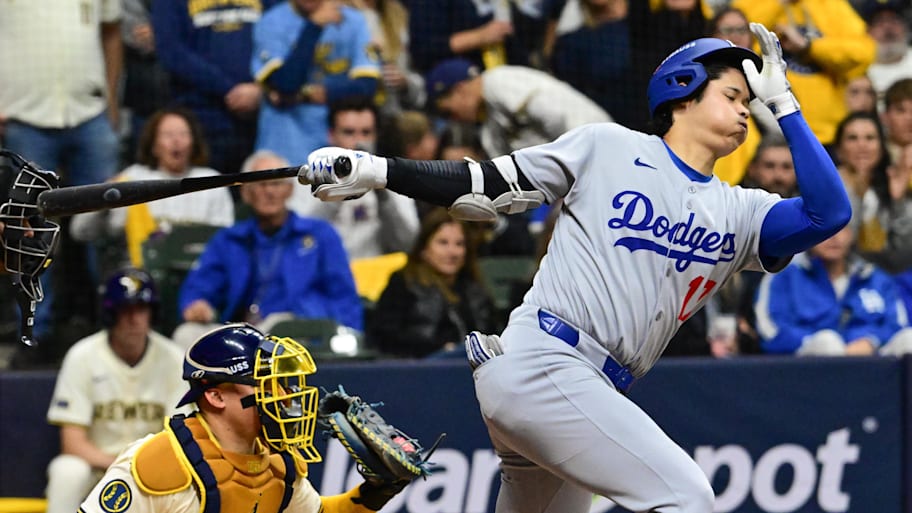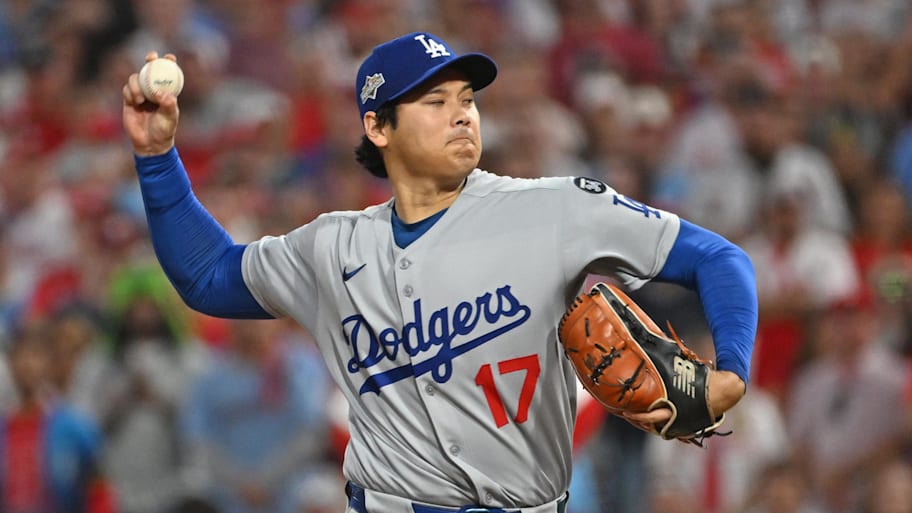LOS ANGELES — From a business perspective, there has never been any question that Shohei Ohtani is most valuable to the Dodgers as a two-way star: Designated hitters don’t tend to become national heroes in Japan and earn their teams an estimated $70 million in sponsorship revenue. From the player’s standpoint, there has never been any discussion, either.
“The reason why I’m a two-way player is because that’s who I am, and it’s what I can do,” Ohtani said last week.
But viewed through the lens of baseball, there was reason to be cautious. It wasn’t just the injury concern, although that certainly caught the Dodgers’ attention; Ohtani’s return to pitching this season has come after his second elbow reconstruction. “There is a cost,” acknowledges manager Dave Roberts. He adds, “What [another ailment] would essentially do is lose two players.”
Questions about Ohtani’s two-way ability
Over the past two weeks, as Ohtani has limped through a 6-for-38 postseason, the potential downside has become more apparent. His start on Friday, in Game 4 of the National League Championship Series against the Brewers, comes with a chance to send his team back to the World Series and to answer the question the baseball world is asking: Is his attempt to be a world-class pitcher affecting his status as a world-class hitter?
Ohtani says it isn’t.
“I don’t necessarily think that the pitching has affected my hitting performance,” he said through interpreter Will Ireton before Game 3 of the National League Championship Series, a 3–1 win over the Brewers that brought the Dodgers a win from a chance to defend their 2024 title. “Just on the pitching side, as long as I control what I can control, I feel pretty good about putting up results. On the hitting side, just the stance, the mechanics, it’s a constant work in progress. I don’t necessarily think so. It’s hard to say.”
Later, he pointed out, “I do feel like I was able to just have a pretty good season offensively.”

Indeed, that was what made Roberts pause when Ohtani began ramping back up as a pitcher. The process would be complicated; the team could not afford to lose his bat by sending him on a rehab assignment, meaning he would have to do all his work in the majors, against major league hitters, in games that counted in the major league standings. And because the rules allow him to remain in the game as the DH only when he started as a pitcher, not when he came in as a reliever, the team had to rearrange the rest of the rotation’s workload to accommodate him even when he was throwing just an inning or two. And every pitch carried the risk of another catastrophic injury.
Wouldn’t it be enough to enjoy employing the best hitter on the planet, a man who chartered the 50–50 club last year almost for something to do while his arm healed, a player who will this offseason almost certainly win his third straight Most Valuable Player award and fourth in five years?
“I think that there’s something to that, if I’m being honest, if you’re talking about potentially trying to protect the player,” Roberts says.
Dodgers president Stan Kasten is less careful. “We’ve run that math and our math says let’s still try to get this out of him,” he says. “The risk of him getting hurt or not being effective is worth what we are getting from him, because the upside is extraordinary and historic.” He adds, “We don’t know that he can do both for 10 years. And we didn’t know that when we signed him, and that was a risk we were willing to take.”
A different hitter when he pitches
In some ways, it doesn’t matter what the Dodgers wanted. “Ultimately this is something Shohei has dreamt about,” Roberts says, “And to try to play God and take it out of his hands, something that he has wanted and worked so hard to accomplish, I don’t think was right. And so to give him and us the best opportunity to succeed at both, I think we as an organization have done a fantastic job with that.”
In some ways, they have. Ohtani made 14 appearances on the mound, pitching to a 2.87 ERA in 47 innings, and he hit .282 and slugged .622 this season, best in the National League, with a walk-to-strikeout ratio of 0.58. But on the days he pitched, those offensive numbers dipped to .214, .536 and 0.40, respectively; on the days immediately following his starts, they were even worse: .147, .294 and 0.17. (As often as possible—six of 14 times—the team had him start the day before a scheduled off-day to build in extra rest.)
Still, his offensive approach remained reasonably intact this summer. During the regular season on days he did not pitch, he swung and missed at 13.8% of the pitches he saw outside the strike zone. On his start days, that number was similar—13.4%. In the postseason, though, he has chased more as a hitter—15.3%—and as a pitcher—42.9%. The sample is small: He has only started one game in October as a pitcher and he saw just seven pitches outside the zone, but he swung and missed at three of them. He went six innings and gave up three runs in the first postseason start of his career, a game the Dodgers won—a trade-off they seemed happy enough to make.
Cristopher Sánchez strikes out Shohei Ohtani on 3 pitches!
— MLB (@MLB) October 4, 2025
We're off and running in Philly 😤 #NLDS pic.twitter.com/X1icrRm6Zb
How could one not affect the other? Ohtani is so busy with his pitching routine and scouting reports on his start day that he tends to skip the hitters’ meeting. His teammates rarely fill him in on what he missed. There wouldn’t be much point: His stated approach never varies. “‘Middle-middle’ is all he says,” says first baseman Freddie Freeman with a laugh. “He says ‘Middle-middle’ in every single hitters’ meeting, and then they’ll show damage clips and he’ll hit pitches [a foot] off the plate for a home run, and we’re like, ‘Middle-middle?’ Middle-middle in his head!” (Ohtani, for his part, describes it thus: “Swing at strikes and not swing at balls.”)
The Dodgers’ brass has emphasized how good the opponents have been. After Ohtani went 1-for-18 with nine strikeouts in the Division Series, president of baseball operations Andrew Friedman called the Phillies’ performance against Ohtani “the most impressive execution against a hitter I’ve ever seen.” After the team pushed back Ohtani’s NLCS start—he would have been rested enough to pitch Game 2, which would have given him an off-day before his next night at the plate, but he will instead pitch Game 4—Roberts insisted the change did not reflect an attempt to get something going offensively.
Still, they need their leadoff hitter to start hitting. “We’re not going to win the World Series with that sort of performance,” Roberts said before the NLCS began. “So we’re counting on a recalibration, getting back into the strike zone and understanding when he faces left-handed pitching what they’re gonna try to do—crowd him in, off [the plate], spin him away. He’s just gotta be better at managing the hitting zone. I’m counting on it. We’re all counting on it.”
And Roberts acknowledged that he felt Ohtani was getting frustrated with his offensive ineptitude. “I think that’s expected,” the manager said. “I don’t mind it. I like the edge.”
A breakthrough is always just a swing away
For the first time all season, Ohtani took batting practice on the field at Dodger Stadium during the team’s workout before Game 3, in what Roberts termed an attempt to “change things up.”
Meanwhile, at least some of Ohtani’s teammates see the tension as obvious. They just think it’s worth it.
Shohei triples and Mookie delivers! pic.twitter.com/wH5SjoMTVg
— Los Angeles Dodgers (@Dodgers) October 16, 2025
“When he’s pitching, he’s in total control of the game,” says Freeman. “When he’s hitting, he’s out there for four and a half minutes. That’s why I don't think he’s hitting as well on the days he starts, because he’s so in the zone. He wants to pitch so good. It’s almost like he’s not turning off the pitching mind. But then I say that, and [on Friday], he’ll probably lead off the game with a home run.”
That’s the thing about Ohtani: He is always one pitch away from doing something incredible. He knows it. The Dodgers know it. The baseball world knows it. So he will continue to hit and he will continue to pitch. And he will continue to chase history—just as soon as he stops chasing pitches outside the strike zone.
More MLB on Sports Illustrated
This article was originally published on www.si.com as Dodgers’ Playoff Run Shows the Risk of Shohei Ohtani’s Two-Way Stardom.
